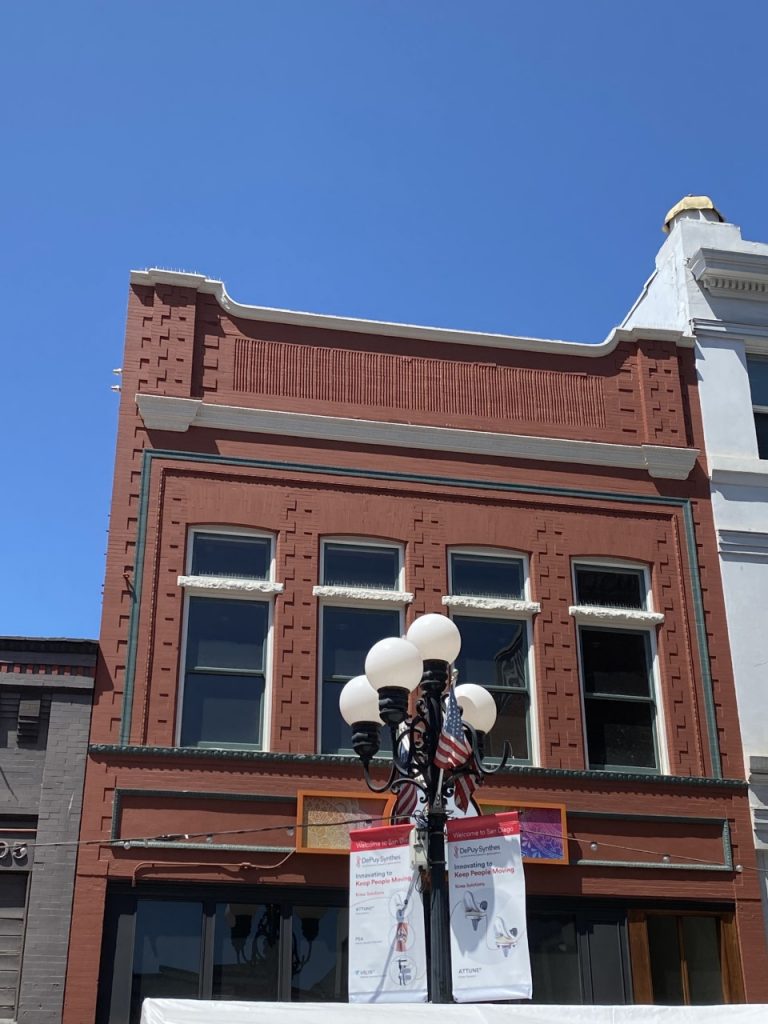No products in the cart.
Landmarks
Housing Who’s Who in SD
The Dunham Building
(1888)
750-752 Fifth Avenue
Architect – William S. Hebbard
Architectural Style – Victorian Commercial
Although the Dunham Building, a very utilitarian edifice , has a somewhat uninspiring facade, it is associated with many of San Diego’s early “movers and shakers” in business and real estate.
Firstly, on November 9, 1869, Alonzo Horton, San Diego’s Founding Father, sold to Mrs. Augusta B. Dunham, a widow and longtime San Diego resident, the present site of the building for $2,000. This was a large sum for the property. She promptly subdivided the property, and in 1882, leased the south half of the property. It supported a wooden structure known as the “Free Reading Room,” which had begun in 1873. This, too, was associated with Alonzo Horton, as he had planned to sell his personal and very valuable library to the Reading Room Association. George Marston , another early San Diego pioneer, philanthropist and merchant, was a board member of the association. Horton offered to sell the book collection to the association for half of their worth ($1,000), but the association balked, so Horton kept his books. Horton and the association finally made their peace, and he did donate the book collection. However, the association had no librarian, only a caretaker with no organizational skills, so many of the books were stolen, and the Free Reading Room closed by 1882.
On May 30, 1887, George E. Dunham, the son of Augusta Dunham, sold half of the Dunham site to David Reed, a pioneer real estate developer, lawyer and insurance agent. Reed became Harbor Commissioner, and was eventually elected Mayor of San Diego in 1897.
By 1887, a wooden structure had been erected at the 750 address. It had a shingle roof and a brick chimney. Lewis and Stocking Real Estate was located at the site. One of the owners, H.F. Stocking, became Superintendent of San Diego Parks. Adjoining the real estate office was J. M. Van Zandt’s shoe and boot store , which was easily seen from either end of the street by the “Big Boot” sign outside its door. Mr. Van Zandt served as the deputy sheriff for the city during the 1880s.
In 1888, the present building located at 750-52 Fifth was constructed, and became known as the Dunham Building. Designed by prominent architect, William S. Hebbard, the building was a two-story brick structure with a large skylight on the second floor. It featured iron chimneys and iron shutters on the windows. The interior doors were mahogany, and the rooms featured 14’ ceilings and hardwood floors. The second floor was intended for offices and meeting rooms; a frame partition separated the meeting rooms from the offices. The first floor was designed to house commercial enterprises.
The original tenant was F. F. Wright and Company, who advertised themselves as “a model shoe house.” They claimed to have the best facilities, the largest assortment, lower prices and the latest styles! Other tenants included celebrated architect Irving Gill and his nephew, Louis Gill. Louis Gill went on to found the San Diego chapter of AIA and was appointed to the State Board of Architectural Examiners. He designed Scripp’s Memorial Hospital, the Bishop’s School and several animal grottos for the San Diego Zoo. His uncle, Irving, designed the Holly Sefton Memorial Hospital, the George W. Marston house, the H. H. Timken house, the La Jolla Women’s Club, the Scripp’s Institute of Oceanography and numerous other buildings, not only in California, but also on the East Coast.
Another tenant was A. E. Banks, a noted physician, who practiced in San Diego until 1940, and was a San Diego health officer. He had been partially blinded, and later invented the portable braille writer known as the Banks Pocket Braille Writer. This ingenious machine was produced by IBM and distributed by the Lions Clubs of America.
Consequent tenants at the site were a pawnbroker, a jeweler, hotels, taverns, restaurants and billiard halls. In the 1920s and 1930s, the Bachelor Club and the Hercules Club, both social clubs for men, occupied the premises as well.
A series of ethnic restaurants were housed at the site throughout the years, with Little Joe’s Pizza House remaining a staple throughout the 1980s and 1990s.
Currently, Urban India, featuring Indian cuisine, burgers and cocktail bars makes its home in the Dunham building. Judging by the amazing aromas emanating from their kitchen, this is a most agreeable fusion!
Sandee is the Historian at the Gaslamp Quarter Historical Foundation. She can be reached at [email protected].

